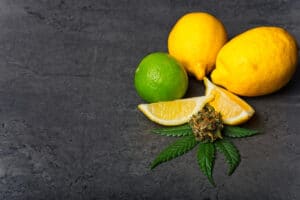
We all know the value of cannabinoids like CBD, as these unique cannabis-derived compounds have a fascinating ability to work with the body’s endocannabinoid system to promote balance and homeostasis in a holistic and systemic way. But cannabinoids are not the only compounds found in the hemp plant, despite their enormous value. The hemp plant naturally contains hundreds of individual compounds in its budding flowers, which each possess their own distinctive properties that can be greatly useful to the body.
These compounds are quite important in terms of what they add to the hemp plant, and we learn this through the popularity of different strains, which we will be getting into more a bit later.
Terpenes 101: Understanding the Basics
Terpenes exist in hemp by the hundreds, yet they usually play second fiddle to CBD. This, despite the fact that they are present in the majority of hemp products that are on the market. Like we said, terpenes are secondary compounds in hemp, meaning that they are not the main compounds responsible for the overall effects of the plant. Still, their contribution to its effects can be significant.
Terpenes are compounds that occur in all plant life. What this means is that you have been consuming terpenes your entire life, whether you’ve known it or not. Terpenes are in the vegetation that we eat as parts of our daily diets. They are the active compounds in essential oils, which are responsible for the oils’ effects. For instance, if you’ve ever felt a calming sensation after using lavender essential oil, you have terpenes to thank.
So, what do these compounds actually do? In terms of the plants to which they belong, quite a bit. Terpenes determine the flavor and aroma profiles of plants, and each plant has its own unique spectrum of terpenes present in its chemical composition.
Terpenes can:
- give black pepper its bite
- provide peppermint its invigorating scent and flavor.
- give roses their intoxicating aroma
- allow lavender to promote relaxation just from smelling its beautiful flowers.
Terpenes do a lot more than that, too. They act as a plant’s defense mechanism, keeping pests and fungal attackers at bay with unique properties that fend off insects and more. Therefore, terpenes are actually critical to the survival of plants in nature.
So, what happens when we extract terpenes and consume them, like we do when we take most hemp products? Terpenes have been widely studied for their valuable effects, which is why they are so desirable. For instance, certain terpenes boast relaxing and energizing properties. This is why plants including peppermint and eucalyptus are commonly found in spa products. Other terpenes can actually stimulate nervous system changes that improve our mood, relieving stress or making us feel uplifted or energized.
It’s important to point out that the flavor and aroma of the hemp plant comes from its unique variety of terpenes.
Popular Terpenes in the Hemp Plant, and What They Contribute to Our Experience
Now that you know what terpenes are capable of, here are some specific terpenes that are prominent in hemp.
Myrcene: Primarily known for its calming effects, Indica strains get their reputation from having higher myrcene levels (more on that later). Myrcene adds a spicy, musky flavor and aroma to hemp.
Limonene: Noted for its potential mood-uplifting properties, it’s a terpene that’s also prominent in citrus fruits, thus adding a citrusy quality to hemp.
Linaloool: Active terpene in lavender, and high levels of linalool in hemp give it a calming effect.
Pinene: Known for its mood-lifting properties, and it is prominent in pine needles.
Eucalyptol: The dominant terpene in eucalyptus, it has cooling as well as cognitive-boosting properties.
Borneol: Commonly used as a tension reliever around the world, and has a woody, minty flavor and aroma.
Humulene: May support healthy appetite and is a terpene most commonly associated with hops.
Camphene: Contributes a pine-like flavor to hemp and is known for being a potent antioxidant.
Caryophyllene: Has calming properties and has the taste of black pepper.
Note: There are hundreds of terpenes in any given hemp plant, but these types are considered by many to be the most prominent, and the most highly sought after.
Terpenes and Strains of Hemp
There are hundreds of unique strains of the hemp plant, with the term “strain” describing the specific breed of hemp. The major factor that determines each individual strain is its terpene profile. While the terpenes mentioned above are all prominent in hemp, they can be configured in unique ways that ultimately determine the effects of a strain. In other words, when you choose a specific strain to try, the effects that make that strain stand out are largely from the terpenes in the breed rather than the arrangement of cannabinoids.
There are three types of strains: indica, sativa and hybrid.
- Indica strains have a reputation for being calming, which is why they are often best in the evening.
- Sativa strains can be more invigorating, so they are more popular for daytime use, or for social occasions.
- Hybrid strains involve sativa and an indica parent, offering a middle-ground between indica and sativa effects.
Of course, not all hemp products are available in a variety of strains. If your interest in terpenes has been piqued and you wish to seek out specific strains, consider choosing flower or a vape cartridge, with both of these products typically being available in a variety of strain options.
Getting Terpenes in the Form of Full or Broad Spectrum Hemp
If you want to explore a rich array of terpenes with your daily dose of CBD, and don’t care about the strain from which they were derived, consider choosing a product made with full spectrum or broad spectrum hemp extract. Both of these types of products contain every terpene that naturally occurs in hemp. The only difference between the two is that full spectrum contains a trace amount of THC that’s non-intoxicating. CBD isolate products are terpene-free, as they contain only pure cannabidiol.
Overall, Terpenes Can Take Your CBD Experience to the Next Level
Terpenes offer a lot to a hemp formula, providing additional effects. Not to mention, each has a flavor and aroma that is completely unique. If you wish to explore terpenes to see what they can do for you, choose a product that doesn’t come from CBD isolate. For example, a full or broad spectrum product, or pure CBD flower.
